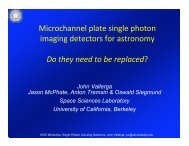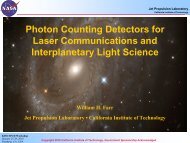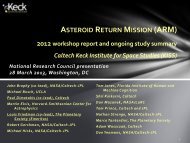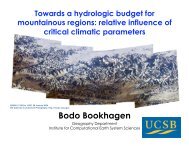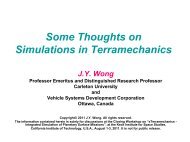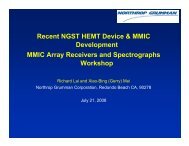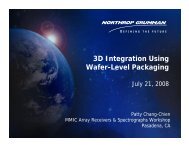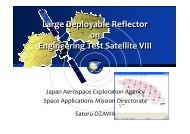Target NEO: Open Global Community NEO Workshop Report
Target NEO: Open Global Community NEO Workshop Report
Target NEO: Open Global Community NEO Workshop Report
You also want an ePaper? Increase the reach of your titles
YUMPU automatically turns print PDFs into web optimized ePapers that Google loves.
DRAFT: RELEASED FOR PUBLIC COMMENTso uncertain that they will be very difficult to find, observe, and effectively characterize to determinetheir suitability as targets for human exploration. Follow-up observations are needed after discoveryto obtain sufficiently accurate orbit determination. Focused efforts with dedicated ground assetsand future space-based assets could greatly reduce unknowns about the <strong>NEO</strong> population within 10years.<strong>NEO</strong>s show a wide range of diversity in their physical characteristics, and while some of thisdiversity is well understood from existing data, further studies are required to help constrain theenvelope of <strong>NEO</strong> physical characteristics that will drive development of systems and operationalconcepts for future human exploration.Characterization of candidate <strong>NEO</strong> targets should therefore include information directly relevantfor human exploration needs. While some of that information can be gleaned from Earth-basedtechniques such as reflectance spectroscopy, radar experiments, lightcurve measurements, and soon, robotic precursor missions are required for some critical characterization details that can onlybe obtained in situ, such as the response of the <strong>NEO</strong> surface to disturbances, debris hazards in the<strong>NEO</strong>’s immediate vicinity, geotechnical data, etc.Even if a set of highly accessible, well-characterized <strong>NEO</strong>s were already known, the challengesof exploring them safely with humans must still be addressed. Mission duration is a primaryfactor in risk management for HSF, and mission knowledge beyond six months is limited. Acuteand long-term physiological effects from radiation in interplanetary space (solar particle eventsand galactic cosmic rays) and crew behavioral health support are critical considerations for longdurationmissions beyond LEO.In conclusion, the <strong>Open</strong> <strong>Global</strong> <strong>Community</strong> <strong>NEO</strong> <strong>Workshop</strong> has provided substantialtechnical review and conclusive peer support for <strong>NEO</strong> precursors, emphasizing thata <strong>NEO</strong> survey mission is necessary to realize a future human exploration mission toa <strong>NEO</strong> in the 2025-2035 timeframe. Just as launch vehicles are a critical need for accessbeyond LEO, so also a space-based survey mission should be considered strategic to the NationalAeronautics and Space Administration (NASA), a critical infrastructure asset necessary for focuseddiscovery, cataloging, and characterization of a more complete and robust set of targets for a morecomprehensive trade-space for future human <strong>NEO</strong> missions. This asset will complete the necessaryinfrastructure, as begun with the available ground-based telescope systems, and is as important asother Agency-wide deep space human mission capabilities to achieve mission success.To provide a viable, robust target set, a space-based survey system should be commissioned onorbitapproximately a decade before the planned human flight to a <strong>NEO</strong>. A system of adequateoperational life (5 to 10 years) can be provided reliably, using full and open competition, for theapproximate cost of a Discovery-class mission. Further, but quite notable, this affordable systemcould also satisfy the intent of the Congressional direction to NASA for Planetary Defense asreviewed by the National Research Council (NRC), will provide a rich data set pertinent to groundbreakingstudies of solar system evolution and interaction for the broader scientific community, andis hugely relevant to the global public in providing significant return on investment for the taxpayerby providing human spaceflight capability, addressing hazards to life here on Earth, and doing moreexploration for less.DRAFT: RELEASED FOR PUBLIC COMMENTiv




